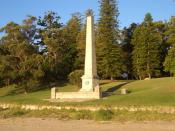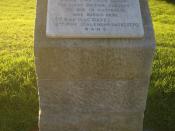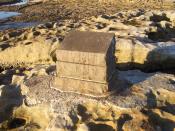At about 7.30 pm on 14 April 1999, a freak hailstormhit Sydney. It affected more houses andpeople than any other natural disaster in Australia'shistory. With a ferocity that shocked theunsuspecting residents and in the space of only45 minutes, more than 500 000 tonnes of hailstonesÃÂ some the size of cricket balls ÃÂdestroyed homes and property. One person waskilled. More than 24 000 buildings were damaged.
About 60 000 cars were damaged, with onethirdso badly damaged they were written off bythe insurance companies. The total cost of thehailstorm was $2000 million.
In thunderstorms, when warm air rises abovefreezing level, water droplets can freeze and fallas hail. However, the hailstorm that hit Sydneyin April 1999 was caused by a much morepowerful thunderstorm ÃÂ known as a super cell.
The very strong updraft of air in a super-cellstorm keeps hailstones suspended inside thecloud for a much longer time than in regularstorms.
The smaller hailstones join together andgrow before becoming too heavy and falling.
Development of a super-cell hailstormANATOMY OF A HAILSTORMStorm movementStrong updraft of 10ñ15 km/hlifts moist air into freezing zone.
Hailstonesleave theupdraft atspeeds of150 km/hand fall12 km toEarth.
Tropopause (top layer of atmosphere)Strong updrafts keep hailstonessuspended much longer than regularstorms, allowing the hail to gain size.
Hailstones rise and fall, getting biggeras they gather moisture and refreeze.
Suburbs from which car insurance claims were lodged withNRMA Insurance by 20 April 1999Stormtroopers cover SydneyArmy troops have been called in belatedly to help protect thehomes of Sydney's distressed residents from further damageafter the disastrous hailstorm. They will join the StateEmergency Service and relief workers from the Rural FireService and New South Wales Fire Brigade, almost doublingthe number of workers to 5000 over the weekend.
The premier conceded that his government may not haveacted quickly enough to help storm victims deal withSydney's biggest-ever storm disaster. The înger has alsobeen pointed at forecasters at the Bureau of Meteorology.
By the time the direction and intensity of the storm cell wasidentiîed, it was already battering Sydney's easternsuburbs. A new radar warning system designed to issuealerts to forecasters was installed at Kurnell one month ago,but meteorologists at the Weather Bureau had not been fullytrained to use it.
Many homes will need to be revisited in a month to havetarpaulins replaced as hundreds of tarpaulins ordered fromChina have been found to be below standard. Shortages ofterracotta tiles and skilled labour mean that many familiesface at least a six-month delay for permanent roof repairsand possibly a wait of several weeks for glass and carpetreplacementhttp://www.fire.nsw.gov.au/page.php?id=470





